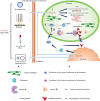Development of chloroplast transformation and gene expression regulation technology in land plants
- PMID: 36407602
- PMCID: PMC9667944
- DOI: 10.3389/fpls.2022.1037038
Development of chloroplast transformation and gene expression regulation technology in land plants
Abstract
Chloroplasts in land plants have their own small circular DNA that is presumed to have originated from cyanobacteria-related endosymbionts, and the chloroplast genome is an attractive target to improve photosynthetic ability and crop yield. However, to date, most transgenic or genetic engineering technologies for plants are restricted to manipulations of the nuclear genome. In this review, we provide a comprehensive overview of chloroplast genetic engineering and regulation of gene expression from the perspective of history and biology, focusing on current and latest methods. In addition, we suggest techniques that may regulate the chloroplast gene expression at the transcriptional or post-transcriptional level.
Keywords: CRISPR/Cas; aptamer; chloroplast genome; dPPR; gene expression; transformation.
Copyright © 2022 An, Wang, Wang and Xiao.
Conflict of interest statement
The authors declare that the research was conducted in the absence of any commercial or financial relationships that could be construed as a potential conflict of interest.
Figures

Similar articles
-
Engineering plastid genomes: methods, tools, and applications in basic research and biotechnology.Annu Rev Plant Biol. 2015;66:211-41. doi: 10.1146/annurev-arplant-050213-040212. Epub 2014 Dec 1. Annu Rev Plant Biol. 2015. PMID: 25494465 Review.
-
Recent trends and advances in chloroplast engineering and transformation methods.Front Plant Sci. 2025 Apr 17;16:1526578. doi: 10.3389/fpls.2025.1526578. eCollection 2025. Front Plant Sci. 2025. PMID: 40313723 Free PMC article. Review.
-
Plastid Transformation: How Does it Work? Can it Be Applied to Crops? What Can it Offer?Int J Mol Sci. 2020 Jul 9;21(14):4854. doi: 10.3390/ijms21144854. Int J Mol Sci. 2020. PMID: 32659946 Free PMC article. Review.
-
Transgenic plastids in basic research and plant biotechnology.J Mol Biol. 2001 Sep 21;312(3):425-38. doi: 10.1006/jmbi.2001.4960. J Mol Biol. 2001. PMID: 11563907 Review.
-
The cyanobacterial CCM as a source of genes for improving photosynthetic CO2 fixation in crop species.J Exp Bot. 2013 Jan;64(3):753-68. doi: 10.1093/jxb/ers257. Epub 2012 Oct 1. J Exp Bot. 2013. PMID: 23028015 Review.
Cited by
-
The chloroplast genome inheritance pattern of the Deli-Nigerian prospection material (NPM) × Yangambi population of Elaeis guineensis Jacq.PeerJ. 2024 May 27;12:e17335. doi: 10.7717/peerj.17335. eCollection 2024. PeerJ. 2024. PMID: 38818457 Free PMC article.
-
Characterization of the complete chloroplast genome of the endangered and endemic bornean fruit Artocarpus tamaran Becc.Front Plant Sci. 2024 Dec 12;15:1513364. doi: 10.3389/fpls.2024.1513364. eCollection 2024. Front Plant Sci. 2024. PMID: 39726425 Free PMC article. No abstract available.
-
Expression of an antimicrobial peptide persulcatusin fused with calmodulin in rice cultured cells.Transgenic Res. 2025 Jun 16;34(1):30. doi: 10.1007/s11248-025-00449-6. Transgenic Res. 2025. PMID: 40522513 Free PMC article.
-
Prokaryote- and Eukaryote-Based Expression Systems: Advances in Post-Pandemic Viral Antigen Production for Vaccines.Int J Mol Sci. 2024 Nov 7;25(22):11979. doi: 10.3390/ijms252211979. Int J Mol Sci. 2024. PMID: 39596049 Free PMC article. Review.
-
Chromatography affinity resin with photosynthetically-sourced protein A ligand.Sci Rep. 2024 Apr 15;14(1):8714. doi: 10.1038/s41598-024-59266-2. Sci Rep. 2024. PMID: 38622266 Free PMC article.
References
Publication types
LinkOut - more resources
Full Text Sources
Other Literature Sources

